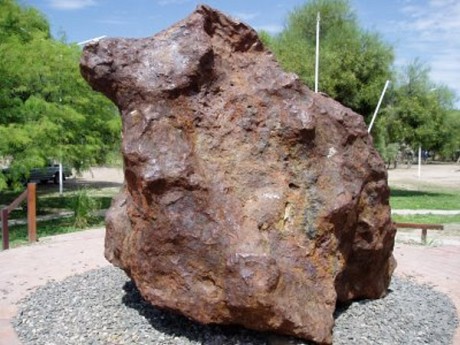The Meson del Fierro April 15, 2011
Author: Beach Combing | in : Modern, Prehistoric , trackbackThe Meson del Fierro was a huge piece of iron in the depths of the Chaco in the badlands of South America (modern Argentina). Eighteenth-century estimates claimed that it weighed about fifteen tons. And, in 1783, Michael Rubin de Celis, A Spanish naval official who had approached the lump of ore with some two hundred men simply could not understand how it had got there: it was half in and half out of the soil unconnected to any other geological feature.
(58-59*) Either this mass was produced on the spot where it lies, or it was conveyed hither by human art, or cast hither by an operation of nature. And whence, by whom or how, could it be conveyed hither, as there are no iron mines within hundreds of leagues, nor remembrance that any have been worked in the kingdom? It could be of no value since it could not be used; and why bring it into a country the most uninhabitable of all the Chaco, from the want of water? Besides how could so heavy a mass be conveyed, the Indians never having known the use of wheel carriage. The mass, therefore, must have been the effect of some volcanic explosion.
Of course, there were no volcanoes in the area…
The meteorite – for so it was – had actually been ‘cast hither by an operation of nature’. Though it is interesting that Rubin de Celis did not consider the possibility that it had come from outside the atmosphere. It was, after all, only at the very end of the eighteenth and in the early nineteenth century – the generation after his visit – that science accepted the possibility that ‘rocks could fall from the sky’, an idea that had been widely ridiculed through the earlier part of the 1700s.
In fact, the region had been hit by a huge iron meteorite that had broken up above the ground c. 2500 B.C.: one modern find, El Chaco (pictured), weighs over thirty tons! Nor was Rubin de Celis the first European surveyor of this particular lump. Previous expeditions had visited the spot in 1779, 1774 and interestingly in 1576 when one Capitan Hernan Mexia de Miraval brought eight soldiers to this visitor from outer space.
What Beachcombing finds most interesting about the find is that there seems to have been a memory among the local population of the meteorite fall: or some extraordinary deduction, a deduction that was quite beyond the Spaniards. The local name for the area Piguem Nonralta was translated into Spanish as Campo del Cielo (‘Field of Heaven’) suggestive as it is of a meteorite explosion.
Then the locals told Hernan Mexia de Miraval that the metal had come from the sky many years previously. If, again we discount a remarkable deduction on the part of the locals, that memory had been passed through about four thousand years. it is an nice example of how the historians’ formula – one that Beachcombing often tells his students – that events can only be remembered orally for three to four generations is suspect.
Any other episodes from the history of meteorites? The Wold Cottage will come another day: drbeachcombing AT yahoo DOT com



